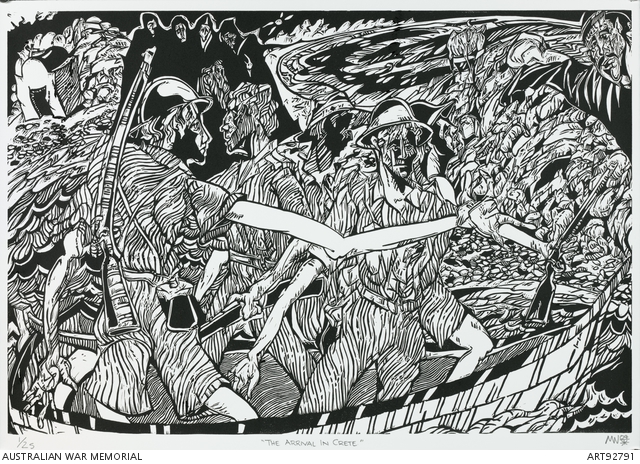Looking back: Australians on Crete -Arrival
In April 1941 the fortunes of the British Empire reached a new low in the struggle against Adolf Hitler and Nazi Germany. Greece had fallen to the Nazis, the Afrika Korps had trapped the 9th Australian Division in Tobruk, and an anti-British revolt had broken out in Iraq. Hitler’s gaze now turned to Crete .
Crete was the destination of many of the Australian, British and New Zealand soldiers fleeing Greece. The Royal Navy conducted their evacuation from Greece in its best tradition, but it was a dangerous operation. German forces pressed the escaping soldiers on the ground, while the bombers of the Luftwaffe prowled above. Not all made it. Bombers caught the Dutch transport Slamat and sunk it with a heavy loss of life.
The troops arrived on Crete exhausted, but relieved to escape. Many landed with just their rifles and the clothes on their backs, some with not even that. At first they slept in the open under olive trees, and cooked on fires using old water cans and discarded food tins. The local population also came to their aid, providing bread and wine. Gradually, the men regained their strength and an army again took shape. But their rest would not last long: the next test against the Germans was only a few weeks off.
Michael Winters
Exhausted troops sail to Crete
linocut on paper, edition 1/25
made in Greece in 2002; printed in Portland, Vic in 2004
50 x 35 cm
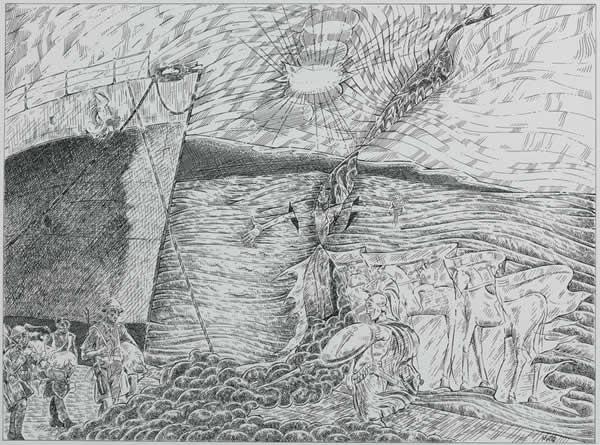
Michael Winters
The arrival of Commonwealth troops and a Roman centurion cutting the curtain of time
pen and ink on card
drawn in Canberra in 2004
50 x 36 cm
OL00475.041
A curtain of time runs through the middle of the work. On one side of the curtain stand Roman centurions who were the officers in charge within the Roman army, the backbone of Roman power. On the other side of the curtain are the Australian soldiers who have just arrived in Crete after sailing from Greece. The use of the curtain of time suggests that these soldiers will be repeating history as they do battle in a landscape that has already seen so much fighting over the centuries.
Michael Winters
Blessing of the troops by the bishop of Xania [Hania]
linocut on paper, edition 1/25
made in Canberra in 2003; printed in Portland, Vic in 2004
35 x 50 cm
Michael Winters
The disembarkation of the troops
linocut on paper, edition 1/25
made in Canberra in 2004; printed in Portland, Vic in 2004
35 x 50 cm
Michael Winters
The arrival in Crete
linocut on paper, edition 1/25
made in Greece in 2002; printed in Portland, Vic in 2004
35 x 50 cm
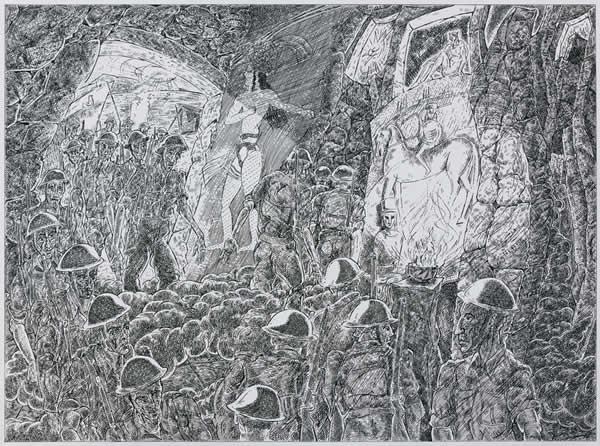
Michael Winters
The troops enter the labyrinth that is Crete
pen and ink on card
drawn in Canberra in 2004
38 x 50.6 cm
OL00475.054
King Minos’ wife Pasiphae gave birth to a monster that was half man, half beast known as the Minotaur. Minos asked Daedalus, a skilled inventor and artisan, to build a maze at Knossos in which to hide the Minotaur. The maze was known as the Labyrinth and it was an edifice with numberless winding passages and turnings opening onto one another and seeming to have neither a beginning nor an end.
In this work Winters has likened the arrival of the Australian troops on Crete to entering the Labyrinth. It was an island with difficult terrain that due to the anticipated arrival of the German troops was dangerous to enter and would later prove almost impossible to escape from.
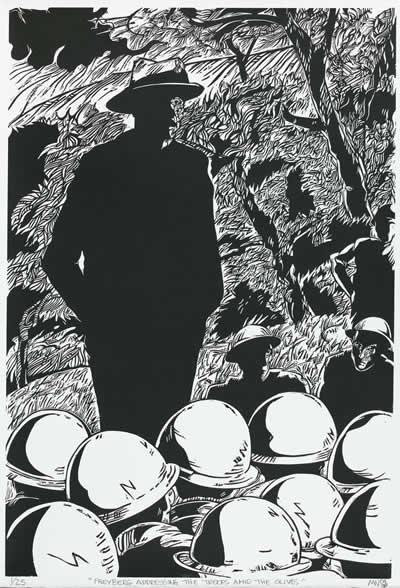
Michael Winters
Freyberg addressing the troops amid the olives
linocut on paper
made in Canberra in 2004; printed in Portland, Vic in 2004
50 x 35 cm
OL00475.010
General Bernard Cyril Freyberg VC, a First World War hero, arrived on Crete with other soldiers from the New Zealand Division to find that he had been appointed as commander of the Allied forces on the island. Although Freyberg was exhausted and under resourced after the Greek campaign he was determined to inspire and encourage the Allied forces.
This work depicts Freyberg addressing the Australian troops, who were defending Rethymnon airfield, amid the olive trees. The dark silhouette of Freyberg in contrast to the light helmets of the soldiers creates an atmosphere of apprehension.
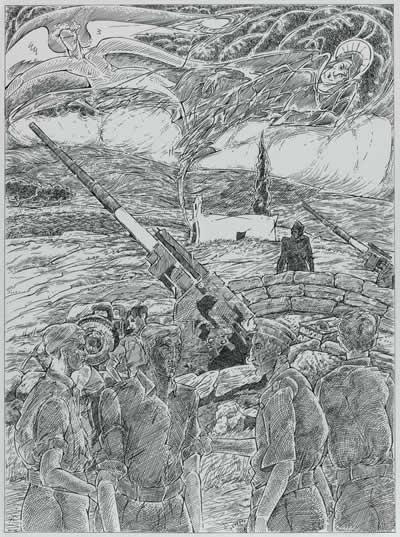
Michael Winters
Gun emplacement, troops and the spirit of Madonna
pen and ink on card
drawn in 2003
50 x 36 cm
OL00475.039
![An Australian soldier in the street of life, Rethymnon [Retimo], April 1941, with snow on Psilioritis [Mount Ida]](/sites/default/files/styles/main_content/public/97441/image/ol004750221.jpg?itok=h2EkaISg)
Michael Winters
An Australian soldier in the street of life, Rethymnon [Retimo], April 1941, with snow on Psilioritis [Mount Ida]
pen and ink on card
drawn in Crete in 1990
52.5 x 37.5 cm
OL00475.022
Michael Winters
The offering of bread from a village to an Australian soldier
Corporal Frank Atkins of C Company 2/11th Battalion had, like the other Australian soldiers, fought in North Africa and Greece without rest and now found himself on Crete facing a new German offensive with limited weapons and supplies. As Atkins marched to Rethymnon, where his battalion was to defend its nearby airport, he saw a village in the distance and decided to search there for food. On his arrival the villagers summoned the priest who spoke English. Frank told him of his soldiers hunger and lack of food. Although the villagers had very little they encouraged Atkins to take some loaves of bread that had just been baked. As the bread was too hot to handle a villager produced a plank of wood and tied the loaves to either end in order for him to carry them.
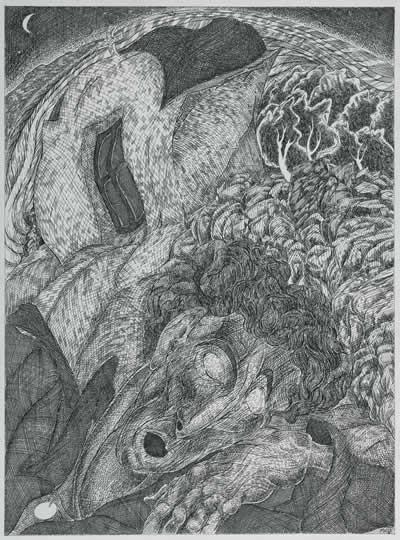
Michael Winters
Sleeping Australian soldier and church
pen and ink on card
drawn in Canberra in 2003
50 x 36 cm
OL00475.040



